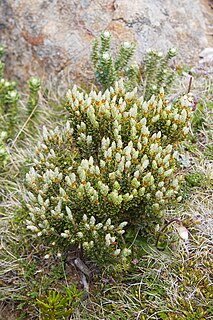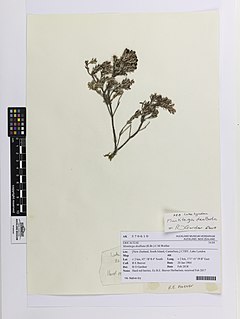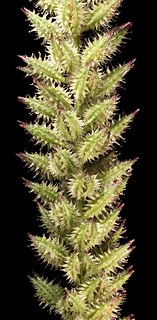
The Ericaceae are a family of flowering plants, commonly known as the heath or heather family, found most commonly in acidic and infertile growing conditions. The family is large, with c. 4250 known species spread across 124 genera, making it the 14th most species-rich family of flowering plants. The many well known and economically important members of the Ericaceae include the cranberry, blueberry, huckleberry, rhododendron, and various common heaths and heathers.

Lotus, a latinization of Greek lōtos, is a genus of flowering plants that includes most bird's-foot trefoils and deervetches and contains many dozens of species distributed worldwide. Depending on the taxonomic authority, roughly between 70 and 150 are accepted. Lotus is a genus of legumes and its members are adapted to a wide range of habitats, from coastal environments to high altitudes.

Arenaria is a genus of flowering plants, within the family Caryophyllaceae.

Ballota (horehound) is a genus of flowering evergreen perennial plants and subshrubs in the family Lamiaceae. native to temperate regions. The Mediterranean region has the highest diversity in the genus, with more isolated locations in South Africa, Central Asia, northern Europe, and the islands of the eastern North Atlantic. It is found in rocky and waste ground.

Salsola is a genus of the subfamily Salsoloideae in the family Amaranthaceae. The genus sensu stricto is distributed in central and southwestern Asia, North Africa, and the Mediterranean. A common name of various members of this genus and related genera is saltwort, for their salt tolerance. The genus name Salsola is from the Latin salsus, meaning "salty".

Leptecophylla is a genus of flowering plants in the family Ericaceae. The genus is native to southeastern Australia, New Zealand, Papua New Guinea and the Pacific Islands. Some species in this genus were formerly classified within the genera Cyathodes, Lissanthe, Styphelia and Trochocarpa.

Leptecophylla juniperina is a species of flowering plant in the family Ericaceae. The species is native to New Zealand and the Australian states of Tasmania and Victoria. The plant's fruit is edible, raw or cooked. Plants grow best in areas with moderate winters and cool moist summers.

Cyathodes is a genus of shrubs within the family Ericaceae. A characteristic feature of the genus is a deeply five-cleft calyx.

Catapodium is a genus of Eurasian and North African plants in the grass family.
Steinchisma is a genus of plants in the grass family, native to the Americas but a few of them naturalized in Africa.

Bassia is a genus of flowering plants in the family Amaranthaceae. They are distributed in the western Mediterranean to eastern Asia. Some occur outside their native ranges as introduced species.

Dasypyrum is a genus of Eurasian and North African plants in the grass family, native to the basins of the Mediterranean, Black, and Caspian Seas.

Tulipa sylvestris, the wild tulip or woodland tulip, is a Eurasian and North African species of wild tulip, a plant in the lily family. Its native range extends from Portugal and Morocco to western China, covering most of the Mediterranean and Black Sea Basins, and Central Asia. The species is also cultivated as an ornamental and naturalized in central and northern Europe as well as a few scattered locations in North America. It was first recorded as being naturalised in Britain in the late 17th century.

Lazare Weiller was a French engineer, industrialist and politician. He was born in Alsace and received a technical education in England and in his cousin's copper factory in Angoulême. He was very interested in the physical sciences, particularly the use of electricity to transmit sound and images. He proposed a system for scanning, transmitting and displaying images that was the basis for experiments by various television pioneers. He sponsored early aviation experiments by the Wright brothers. He founded several companies including a telephone wire manufacturer, a taximeter manufacturer, the first Parisian cab company to use automobiles, an aircraft company and a wireless telegraphy company. He was a deputy during World War I (1914–18) and then a senator until his death.

Poa drummondiana is a perennial herb in the Poaceae family.

Montitega is a genus of flowering plants belonging to the family Ericaceae.
Puccinellia stricta is a species of grass known by the common names Australian saltmarsh grass, and Marshgrass. It was first described by Joseph Dalton Hooker in 1853 as Glyceria stricta from a specimen collected at Akaroa, but was assigned to the genus, Puccinellia, in 1930 by Carl Hilding Blom. It is native to New Zealand and Australia, where it is found in Western Australia, South Australia, Victoria and Tasmania.

Tragus australianus, common names Burr grass, Small burrgrass, and Tickgrass, is a summer ephemeral grass, first described by Stanley Thatcher Blake in 1941. It flowers in response to rain. Its native range is mainland Australia, where it is found in arid and semi-arid areas.
Poa fax is a species of grass in the family Poaceae, native to the Australian states of Western Australia, South Australia, New South Wales, and Victoria. This species has the shortest scientific name of any plant. Poa is Greek for "fodder", and fax is Latin for "torch" or "flame", referring to "its dense, spike-like inflorescence which resembles a torch with ascending tongues of flame". While the name Poa fax is accepted as valid by Flora of Australia, and some databases reflect this, such as POWO, WCSP and FloraBase, other sources such as Tropicos, WFO and GrassBase consider it a synonym of Neuropoa fax.

Epacridoideae is a subfamily of the family Ericaceae. The name StyphelioideaeSweet is also used. The subfamily contains around 35 genera and 545 species. Many species are found in Australasia, others occurring northwards through the Pacific to Southeast Asia, with a small number in South America.














